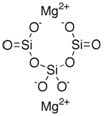Magnesium trisilicate is an inorganic compound that is used as a food additive. The additive is frequently used by fast food chains to absorb fatty acids and extract impurities formed while frying edible oils. It has good acid neutralizing properties.
Manufacture
Prepared from Sodium silicate and Magnesium sulfate.
| Synonyms | Magnesium silicate hydrate, Magnesium silicon oxide |
| CAS no. | 14987-04-3 |
| EINECS no. | 239-076-7 |
| Molecular formula | Mg2O8Si3 |
| Molecular weight | 260.86 |
| Structure |  |
Applications
Magnesium Trisilicate is a common antacid drug that is used for the treatment of indigestion, heartburn, or gastroesophageal reflux disorder (GERD).
| It is also used as |
|---|
| Antioxidant |
| Decolorizing agent |
| Industrial odor absorbent |
SPECIFICATIONS – USP
| Test | Unit | Specification |
|---|---|---|
| Description | – | A white or almost white powder |
| Solubility | – | Practically insoluble in water & in ethanol (96%) |
| Identification | – | A) The Neutralized filtrate responds to the tests for Magnesium B) Silica Floats about in the bead, producing, upon cooling an opaque bead with a web-like structure |
| Water | % | Between 17.0 to 34.0 |
| Soluble salts | – | The residue weight not more than 38.0 mg (1.5%) |
| Chloride | % | Not more than 0.055 |
| Sulfate | % | Not more than 0.5 |
| Free Alkali | – | Not more than 1.0 ml of 0.10 N hydrochloric acid is required |
| Arsenic | ppm | Not more than 8 |
| Acid consuming capacity | – | Between 140 ml to 160 ml of 0.10 N hydrochloric acid |
| Assay as MgO | % | Not less than 20.0 |
| Assay as SiO2 | % | Not less than 45.0 |
| Ratio of SiO2 to MgO | – | Between 2.10 to 2.37 |
STORAGE
The product is stored at ambient temperature protected from moisture
PACKING
25 kg HDPE bags
REGISTRATION / CERTIFICATION
1. WHO-GMP
2. EU-WC (Written Confirmation)
ExSyn offers Magnesium trisilicate on commercial scales and welcomes enquiries. No matter the quantity you need, our exceptional quality and service will make ExSyn your supplier of choice! If you need any additional information or SDS, please contact us.
5-Methyl-3-vinyl-2-oxazolidinone (V-MOX) is a highly reactive monomer valued for its low viscosity, mild odor, and excellent reactivity. It is widely used as a reactive diluent in UV-curable inks and coatings, where it enhances adhesion, produces brighter colors, and improves safety compared to conventional diluents. In addition, V-MOX serves as a key building block in the synthesis of kinetic hydrate inhibitor (KHI) polymers, which are applied in oil and gas production to prevent hydrate blockages in pipelines.
Zinc ricinoleate is the zinc salt of ricinoleic acid, a hydroxylated fatty acid derived mainly from castor oil (Ricinus communis). It appears as a white to slightly yellowish powder, waxy solid, or paste, depending on formulation. Its most valuable property is its ability to trap and absorb odor molecules such as amines, sulfides, and short-chain fatty acids, making it an essential ingredient in deodorant and odor-control products.
2-(tert-Butyl amino)ethyl methacrylate (TBAEMA) is a functional methacrylate monomer that contains a secondary amine group and a hydrophobic tert-butyl moiety, giving it excellent versatility in pH-responsive and adhesion-enhancing polymer systems.
It is valued in printing ink formulations for its ability to enhance adhesion, flexibility, and surface interaction.
Commonly known as potassium bis(fluorosulfonyl)imide (KFSI), the compound has a three-carbon backbone bearing six fluorine atoms and two sulfonimide (-SO₂F) groups. The molecule’s architecture lends it both high chemical stability and useful reactivity. Because of its excellent ionic conductivity and thermal / electrochemical stability, it finds use in advanced electrolyte formulations—for example in lithium-ion and next-generation batteries, in ionic liquids, and in other electrochemical systems.
Colchicine is a naturally occurring alkaloid obtained primarily from the autumn crocus (Colchicum autumnale) and related species. It has been used in medicine for centuries, especially for the treatment of gout and Familial Mediterranean Fever. In modern medicine, Colchicine is valued also in conditions like pericarditis, Behçet’s disease, and certain dermatological and cardiac disorders.
1-Butylimidazole is a versatile organic heterocyclic compound belonging to the imidazole family, where a butyl group (–CH₂–CH₂–CH₂–CH₃) is attached to the nitrogen atom at the 1-position of the imidazole ring. Its applications span organic synthesis, materials science, and bioactive compound development due to its tunable physicochemical properties and structural versatility.
Atropine sulfate monohydrate is a chemical compound, specifically a salt of atropine and sulfuric acid, with one water molecule (monohydrate) attached. It is commonly used as a medication and in research due to its anticholinergic properties, meaning it blocks the effects of acetylcholine at muscarinic receptors.
4-Aminobenzoic acid, commonly abbreviated as PABA, is an aromatic amine and carboxylic acid compound. It consists of a benzene ring substituted with an amino group (–NH₂) in the para position to a carboxylic acid group (–COOH).
2-Amino-5-Nitrophenol (5-NAP) is an organic compound with the molecular formula C₆H₆N₂O₃. It is a substituted phenol with both an amino group (-NH₂) and a nitro group (-NO₂) attached to a benzene ring, along with a hydroxyl group (-OH).
